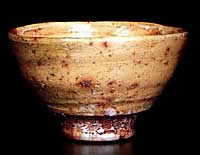 Ido Chawan by Tsujimura Shiro |

Foot of Ido Chawan |
| Chawan and the Soul of a Bowl Of the 14 ceramic objects designated as national treasures in Japan, the fact that eight are chawan (tea bowls) is a clear sign of their importance in the culture. Of these eight, five are actually Chinese tenmoku brought here in the Kamakura (1185-1333) and Muromachi (1333-1568) periods; another is a Korean Ido ware from the Choson Period (1392-1910); one is Japanese Shino ware from the Momoyama Period (1568-1715); and one is Koetsu Honami's (1558-1637) "Fuji" chawan from the Edo Period (1603-1867). It will take me years to even begin to be able to fathom what is going on with chawan; to understand their "spirit," in which simplicity is depth and intelligence, asymmetry is beauty, and cracks and "flaws" are attractive. |
 Ido Chawan by Tsujimura Shiro |

Foot of Ido Chawan |
| "Wind in the Pines" "They are perfect in that, grasped in the light of wisdom-compassion just as they are, they are taken out of time and transcend all the petty judgments and ambitions that fill our lives. They are also imperfect in that they participate in our existence and we in theirs, and therefore, they are subject to all the flaws and infirmities of our lives. By this measure, those objects are most treasured that awaken one to this dual nature of one's existence, that draw one beyond oneself into a world of love that is no-self, and that work, as embodiments and instances of Buddha's compassion, to save one just as one is." By the Bizen great, Anjin Abe Most collectors of chawan have mainly seen tea bowls "that superficially look like chawan, yet chawan they are not. According to philosopher Shin'ichi Hisamatsu (1889-1980) writing in"Zen and the Fine Arts: "With an ordinary bowl much attention is paid to the shape or silhouette of the body, and little to the foot or lip. With a tea bowl for the Way of Tea, however, importance is attached to the lip, inside surface and foot."
Not
any less essential to the creation of a true chawan, is the spirit of the potter. For without an infusion of the craftsman's deep understanding of himself, and of the
mysteries of clay and fire, a tea bowl remains an empty shell.
The
arbiter of tea tastes in the Edo Period was Kobori Enshu, who
nominated the "seven kilns" of Takatori, Agano, Akahada,
Kosobe, Zeze, Shidoro and Asahi as producers of fine chawan.
The same period also saw the creation of colorful, new
Kyoto stonewares, such as Ninsei and
Kenzan.
More information on these and many other lesser-known Japanese
styles can be found in "Chawan Kamabetsu Meikan" by Kuroda
Kazuya.
In
his latest exhibition -- at Nihonbashi Mitsukoshi's
sixth-floor gallery from Jan. 14 to 20, 2003 -- Tsujimura is
showing mainly one style: simple and deep Ido chawan (see
photos at top of page). Of Korean lineage, and dating from the
Choson Period, Ido chawan are characterized by a high foot and
a wide, flaring body. The color of the glaze is usually a
neutral buff tone that perfectly complements the frothy
emerald matcha.
"Amid our daily bustle, a chawan offers a hand-held sanctuary for deep pondering to refresh the spirit and reunite it again with nature. And right now, indeed, we need such refuge and reflection." |
| Return to Chanoyu - Go to Study Guide - Email to Shibui Swords |